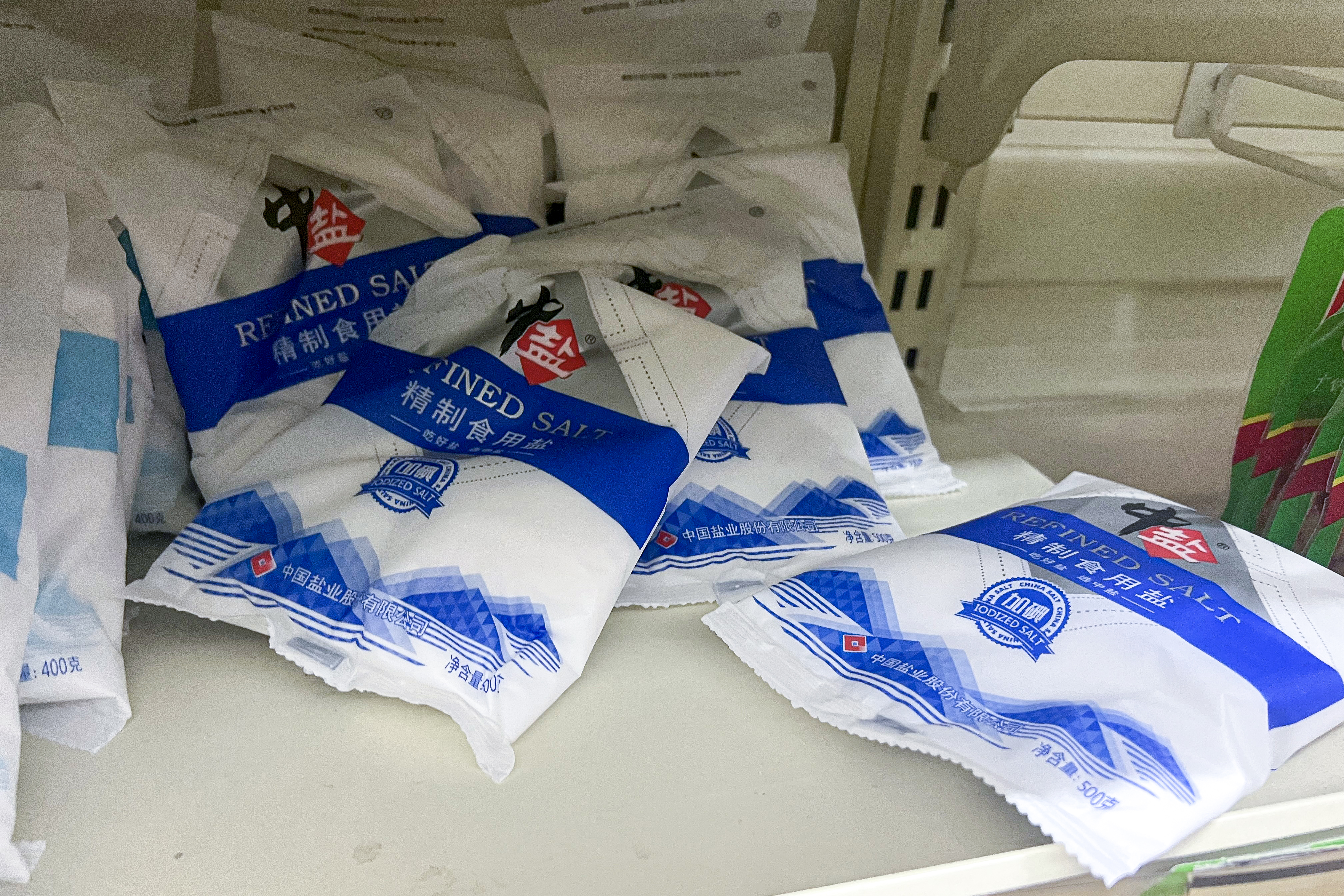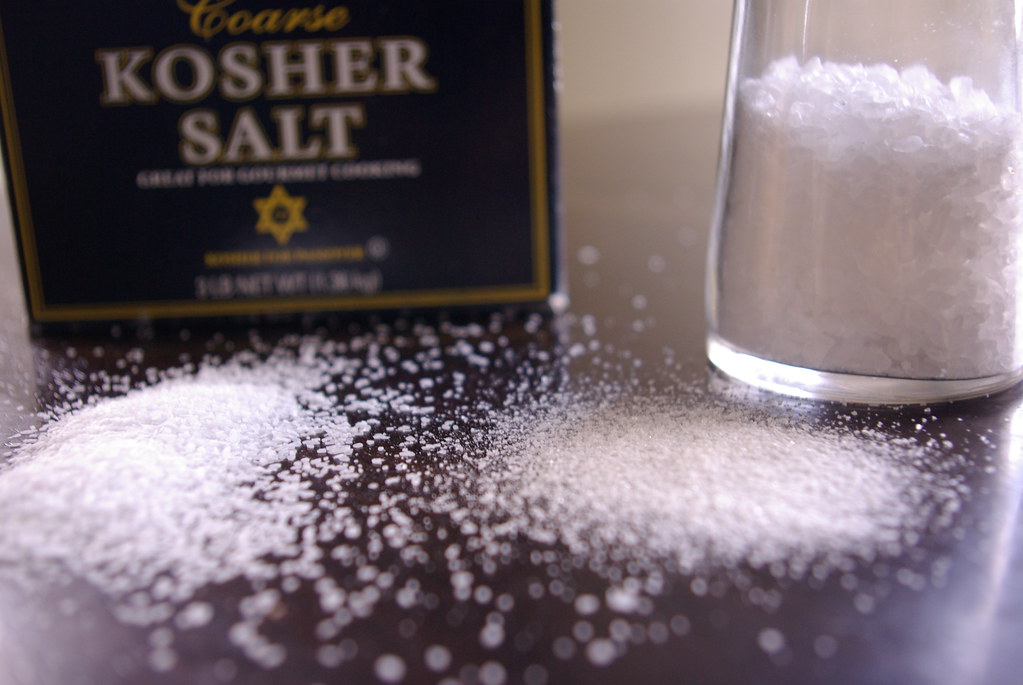This article will examine the different types of salt and how to use them. Additionally, you may mistakenly believe that salt is just that—salt. It’s the same table salt you may find in shakers worldwide.
But as you learn more about artisanal salt, you’ll see many different types, each with distinctive properties, textures, and flavors.
Furthermore, many options are available, from more recent creations like smoked salts to traditional, hand-harvested French salts like fleur de sel.
So why not experiment with different types of salt to tantalize your palate and dazzle your friends?
1. Refined Salt (Table Salt)

Table salt is your typical salt. It comes in little crystals that fit through the gaps in salt shakers. Additionally, you can find it in food service packages, on restaurant tables, and in those cylindrical boxes on grocery store shelves.
However, to avoid the illness known as goiter, iodine has been added to table salt to create iodized salt.
From a culinary perspective, a cook’s objective should be to season a meal well such that additional salt is not required or preferred at the table.
Because of this and the degree to which contemporary home cooks have embraced this method, the amount of table salt used as seasoning has significantly decreased.
Despite this, baking still makes extensive use of table salt. In addition to adding flavor, salt interacts with wheat gluten to increase the dough’s elasticity.
Additionally, because its tiny crystals dissolve easily in the dough, it is the salt of choice when creating bread and other baked goods.
2. Kosher Salt

Kosher salt is also one of the different types of salt you can use to spice up your food. Table salt is refined more than kosher salt.
Generally, it is coarse grain, unionized salt, though certain brands may also contain an anti-caking ingredient.
It can be kosher, although its term stems from traditionally “kosher” meat by removing the blood.
Some companies started marking their salt as kosher, and the word remained to set it apart from finer table salt.
Kosher salt can be used anywhere conventional table salt is used. Its big grains make it perfect for hand-salting, making grabbing a pinch to season your meat or stew simple.
Just keep in mind that it is less ideal for recipes that call for precisely measured amounts because the size of the crystals varies from brand to brand.
Furthermore, it’s a fantastic choice for rubs or any meal where its robust taste and crispy texture will add flavor and texture.
3. Sea Salt
Of course, the sea is the primary salt supplier around the globe. However, the salt reserves underneath are also mined to create salt for food.
But these subsurface deposits were made by long-gone seas thousands of years ago. E
The salt deposits in the Himalayan Mountain range are remnants from the millions of years before the mountains were formed when the area was submerged.
In any instance, saltwater is evaporated to create items marketed as “sea salt.” Their labels identify several varieties, each having unique traits and flavors derived from trace components.
Additionally, Sea salts can be flakes, fine, or coarse crystals. Depending on these factors and how they are made, they can display various colors from regional minerals and algae.
4. Himalayan Pink Salt
Himalayan pink salt is another type of salt gaining popularity among chefs and consumers. It is harvested from underground salt mines in the Himalayas’ foothills.
The harvesting process is very similar to that of traditional salt mining. Miners extract salt through natural oxidation instead of evaporation.
Additionally, this means that the salt is exposed to oxygen in the air, which causes the mineral to oxidize into a reddish color. The resulting salt has a distinctive flavor and aroma reminiscent of the ocean.
5. Black Diamond Crystal Salt
Black diamond crystal salt is another type of sea salt from the Dead Sea, and it is used to spice up food.
It is produced by evaporating water from the brine pools at the bottom of the lake. This creates a thick, dark substance that contains many minerals, including magnesium chloride.
Black Diamond Crystal Salt is often sold in large blocks, making it easier to cut and grind into smaller sizes if necessary.
6. Curing And Bringing Salt
Salt is an essential ingredient in brines for pickling vegetables, curing meats, drying, and preserving meats due to salt preservation characteristics that result from its capacity to suck water out of foods.
Smoking meats is frequently used for preservation in addition to curing or bringing them. While all salts have these preservation qualities, there are also special curing salts and bringing salts created specifically for their intended use.
Furthermore, Curing salt, for instance, is regular salt with a small amount of sodium nitrate added since this substance works well to kill the microorganisms that cause botulism.
7. Flake Salt
Large, flat salt flakes are the distinguishing feature of flake salt. Although it can occur naturally, it is typically created by evaporating or boiling brine.
These techniques typically produce fine salt shavings with a saltier flavor since they have less mineral concentration than other salt varieties.
Additionally, Flakes are perfect for use as finishing salt because of their wide surface area, allowing the flakes to dissolve quickly while maintaining a crunchy quality.
You can use flake salt in any dish you like. However, given its peculiar qualities and “melting crunchiness,” it would work best in sweet foods like cookies, ice cream, or desserts made with caramel or chocolate.
8. Himalayan Black Salt
Himalayan black salt, sometimes called “Kala Namak,” is a staple in many traditional South Asian dishes. It is produced using salt reserves found in the Himalayas.
However, these salts are kiln-fired in sealed vessels with charcoal, local seeds, bark, and several other local components.
Additionally, after cooling, the salt is aged. The salt contains iron sulfide, which makes it black; traces of magnesium and sulfates are also found.
You could notice that Kala Namak releases a relatively strong odor when initially put into food because of the sulfur it contains. But eventually, this goes away, leaving you with a savory flavor that tastes like egg yolks.
9. Specialty Salt And Seasoned Salt
Next on our list of different salts are the Speciality salts and Seasoned Salts. The abundance of specialty salts, such as Himalayan pink salt (see above) and Hawaiian black salt, makes up for their lack of universal applicability.
Additionally, if applying it as a garnish, do so before serving because many of these salts will dissolve quickly.
To create seasoning blends, seasoned salts like celery salt and garlic salt are blended with other ingredients, herbs, and spices rather than specific types of salt.
10. Hawaiian Alaea Salt
This salt, also referred to as “Hawaiian Red Salt,” is produced where the Pacific Ocean meets the coasts of Hawaii.
After being extracted, salt is combined with red alaea volcanic clay. This clay’s hue is brick red and contains minerals and iron oxide.
Furthermore, it was traditionally utilized in Hawaiian ceremonies to promote healing, blessings, and purification because it was thought to have mystical qualities.
A little bit of Hawaiian alaea salt goes a long way. It is prized for its ability to maintain taste during cooking and is a traditional ingredient in cuisines like Hawaiian poke and pork kalua.
Use it as an eye-catching garnish on any light-colored dish or to add authenticity to grilled fish.
11. Smoked Salt
Smoked Salt is also a type of salt you can use. If you’re seeking a chemical-free alternative to liquid smoke or want to add a trace of smoke to your cooking, why not try smoked salt?
Natural sea salts are slowly smoked over many days to produce smoked salts, which come in smokey aromas like hickory, Alderwood, and maple.
Furthermore, smoked salts are an easy and quick approach to enhancing the flavor of most recipes.
Depending on the smoked salt you choose, you could add flavor to poultry recipes or use it as a dry rub for ribs.
Or sprinkle it over red meat to give it a lovely, aromatic tinge. Additionally, it is a fantastic addition to vegetarian and fish recipes.
12. Sale di Cervia
The Italian equivalent of the French fleur de sel is called sale di Cervia. You might mistake one for the other because they are identically made in small salt flats and are collected with conventional wooden rakes.
However, these premium gourmet sea salts are highly different from one another, much like the Atlantic Ocean and the Adriatic Sea are very different.
Sale di Cervia is a great finishing salt for many cuisines because it doesn’t have the salty flavor of fleur de sel. Any recipe will be improved by its delicate flavor and rich mineral content, from vegetables to grilled fish.
13. Celtic Salt
Celtic salt, also known as “sel gris” or “gray salt,” is hand-harvested from tidal ponds off the French coast of the Atlantic.
In addition, this salt’s gray hue and almost-moist feel result from the clay. This labor-intensive, coarse-grained salt is expensive and rich in minerals, but its distinctive flavor makes it highly valued.
This salt can be used as a finishing salt and a cooking salt. Its mild, saline flavor complements pasta, fish, and shellfish recipes. Additionally, it is an excellent choice for rimming cocktail glasses due to its wet texture.
14. Fleur De Sel
Rounding off our list of different types of salt is Fleur de sel, the “caviar of salts.” It is one of the most expensive salts you can purchase.
It is gathered similarly to Celtic salt, but it requires significantly more work and can only be harvested under specific conditions.
Furthermore, the tiny, thin fleur de sel crystals are skimmed from the water’s surface.
The restricted annual production and high prices are due to the fact that this can only be done using traditional procedures on dry, warm days with a light breeze.
Like sel gris, this salt has a delicate, saline flavor and retains moisture. It can be used as a finishing salt to improve all dishes, particularly seafood, fish, and vegetables.
While it frequently gets a poor rap, salt is necessary for good cuisine. It even plays a significant role in some artisanal items, such as soap!
Instead of always seasoning your food with plain old table salt, broaden your culinary horizons. You can also try these other salt varieties for a delicious punch of novel flavors and textures!
This article will examine the different types of salt and how to use them. Additionally, you may mistakenly believe that salt is just that—salt. It’s the same common table salt that you may find in shakers worldwide.
But as you learn more about artisanal salt, you’ll see that there are many different types, each with distinctive properties, textures, and flavors.
Furthermore, many options are available, from more recent creations like smoked salts to traditional, hand-harvested French salts like fleur de sel. So why not experiment with different types of salt to tantalize your palate and dazzle your friends?








